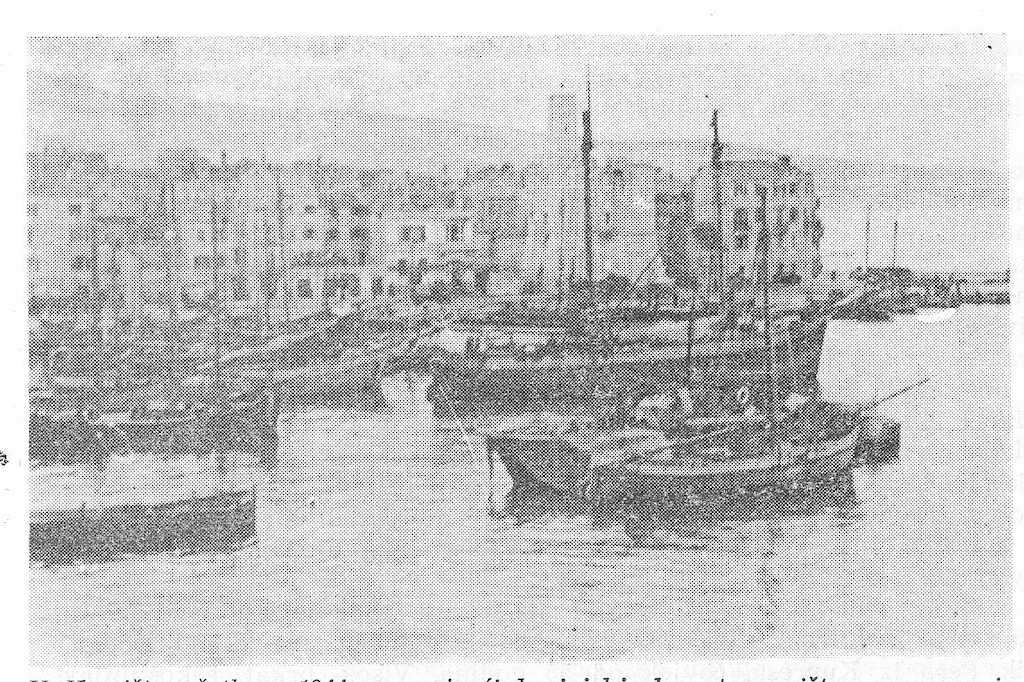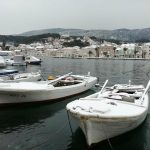Arriving on Hvar in February this year to check on the house in Vrboska meant venturing down to the riva only in rare intervals of clear cold winter sunshine between days of incessant rain. Missed the snow however. After catching up with neighbours for pizza and beers in Paparazzi and Škojic, nothing for it, but to sit with a book by the kitchen fire and reflect on real the hardships endured by islanders 74 years previously.
During the winter of 1943/44, following the Italian capitulation, the Germans mounted a ferocious offensive to keep control of the Adriatic coast and protect their southern flank from Allied attack. Encircling Tito’s main forces in Western Bosnia, they flooded into the Dalmatian coast. By 21 December they were on Korcula and by 19 January they were on Hvar. They had driven before them large numbers of refugees, mostly the very young and the elderly, swelling the islands’ population by more than 15,000, most of them on Hvar.
Fitzroy Maclean, SOE’s envoy to Tito, had persuaded Churchill to respond to the Partisan leader’s request for assistance by deploying a large group of Royal Navy Commandos alongside US troops on Vis. It was clear to the Allies, though, that the refugees would have to be evacuated before serious fighting could ensue. Paul Bradbury’s for TCN article of Nov 2011 tells the story of the transport of thousands of refugees in severe hardship to Bari and thence to Egypt to the refugee camp at El Shatt. That freed the Allies to mount increasingly heavy raids on German island garrisons.

Initially, small teams of Commandos were sent to link up with Partisan forces on the islands. On Hvar, most of the adult population either covertly or overtly sided with the Partisans. Several hundred men and women were enlisted to Divisions of the Partisan Dalmatian Brigade and operated from settlements along the hilltop spine of the island. Most of the population sympathised with them, supplying them with food and equipment and passing on intelligence which they shared with the British recce teams.
On 3 February a troop of Commandos led the first attack on the fort above Hvar town, capturing 4 German prisoners who provided useful intelligence. They lost their leader in that action. Captain Bare became the first British serviceman to be buried in the Naval Cemetery on Vis since the Napoleonic Wars alongside Richard Anson, killed in action on his frigate in 1811. A similar attack took place in Vrboska in late February. The Partisans followed these up, constantly harassing the German outposts outside Hvar, Stari Grad and Jelsa. As they grew in strength, their Commanders agreed that they should be withdrawn to Vis to form the 1st and 4th Battalions of the Dalmatia Brigade and prepared to reinforce the Commando raiding parties.
The first of the big island raids, consisting of 180 Commandos and 138 US troops (mostly of Yugoslav origin), went in on the German-held village of Grohote on Šolta on 18 March. Two days later, British recce groups on Hvar were sending coded signals describing drastic action being taken by the Germans on Hvar as a result of the Šolta raid. An intelligence officer was sent to Hvar to obtain a full report. At 0600 on 23 March Lieutenant Frost returned to Vis and confirmed that the Germans were withdrawing from their positions in Hvar and Stari Grad to Jelsa where their troops would be evacuated across to Bol on the island of Brač.
The Commando War Diary records that, on 23 March, the troop commanders held conference and decided at 1100 that the planned op on Hvar was a go. At 1430, a combined raiding force embarked from Vis. 43 RN Commando sailed with 280 men (4 fighting and 1 heavy weapons troops) in their Landing Craft. They were followed by 400 Partisans of 1 and 4 Battalions Dalmatian Brigade in 5 schooners. At 1730 the LCI sailed round Sčedro and achieved “dryshod landing” at Gromin Dolac, a stretch of beach identified as perfect for a quick ascent up and over the central ridge to the north coast. The schooners then disembarked their troops at 2000. The diary records that the RAF had bombed Jelsa (and probably Vrboska) at 1600 in an attempt to disrupt any evacuation.
At 2200 the Commandos moved into position above Jelsa, the heavy weapons troop on a spur overlooking the harbour, while a second troop descended towards the town where they came upon a large formation moving towards them. Uncertain whether these were local Partisans, the troop Captain broke cover to identify them and immediately attracted heavy machine gun fire from front and flanks. Captain Hudspith then rejoined his troop and led them on a direct assault on the enemy troops, routed them leaving 5 dead and taking 4 prisoners and all their mule baggage train. For this he was later awarded the Military Cross.
By that time it was clear that those Germans who had not already been evacuated were breaking out of Jelsa and withdrawing east to Sučuraj. The rest of the night and most of the following day was occupied in pursuit of the remaining German troops across the island. The 1st Partisans Battalion remained on the high ground overlooking the town to act as reserve, while the other joined the Commandos in pursuing the Germans as they broke out onto the high ground above Jelsa and dispersed. One section of the hunting group was sent along north coast track to Humac to cut off the enemy there and the remainder went on to Juraj to prevent them reaching Sučuraj.
These units engaged the enemy at several points as far as Poljica, killing and capturing many of them but unable to prevent them from splitting into small groups and dispersing.
In the evening of 23 March, the raid Commander decided the raid objectives were achieved. The British troops were withdrawn, and by 0500, 43 Commando were back on Vis. Hvar was now effectively divided, with the Germans driven to the eastern half from Bogomolj to Sučuraj, and the Partisans controlling the west with the 4th Battalion in Pitva and the 1st Battalion in Brusje.
The Germans suffered 32 killed and 152 captured, while the Partisan losses were three dead and 20 wounded. The British suffered only three wounded. They believed they had swept the Germans out of Hvar. The Partisans better understood the outcome of the raid. The Germans were regrouping not retreating. The Partisans decided to withdraw their two battalions to Vis, and during the night of 28/29 March 420 troops and 437 refugees were evacuated. Only a small partisan detachment was then left on Hvar island. With reinforcements arriving on 27 March, the Germans began a slow advance toward Jelsa, during the night of 29/30 March sailed from Sumartina to make a landing near Jelsa, and on 1 April 1944 they again took control of Stari Grad.
The big raids from Vis compelled the Germans to change their island defences. They would no longer locate their garrisons in requisitioned schools and other buildings in villages, where they could be easily surrounded and were easy target for air attacks. Ultra intercepts of German cypher signals confirmed that they had detected the embarkation from Vis and almost completed an orderly withdrawal from Hvar before it had been interrupted by the raid. They were to return in force, withdrawing into heavily fortified quarters protected by trenches, barbed wire and land mines to buy the time for reaction forces to be deployed swiftly from the mainland.
The premature RAF attack had forewarned the enemy of an attack on Jelsa. But Allied aircraft also sank several German landing craft and barges, a major blow to the capabilities of the German navy in Adriatic.
Looking back on those distant events and reading the personal accounts from the Split and UK National Archives, it is remarkable how well the specialist British and Partisan guerrilla troops were able to collaborate with virtually no field communications and very few interpreters. There was mutual respect for their fighting prowess, the Commandos especially impressed with the Partisan women fighters, one of whom died in the action. The Germans had deliberately not used Croatian NDH troops in their coastal offensive rightly fearing that they would defect in large numbers to the Partisans. Instead they used forcibly conscripted Italian, Czech and Polish troops mixed in with their own troops among whom were the notorious Prinz Eugen SS Division with their “death’s head” cap badges. The latter began “evacuating “the remaining adult male population of the coastal and island villages to mainland labour camps. That predictably acted as a recruiting sergeant for the Partisans and destroyed any idea of the NDH as other than a puppet of Nazi Germany.
In the phrase of the time, this was not the beginning of the end but the end of the beginning.











